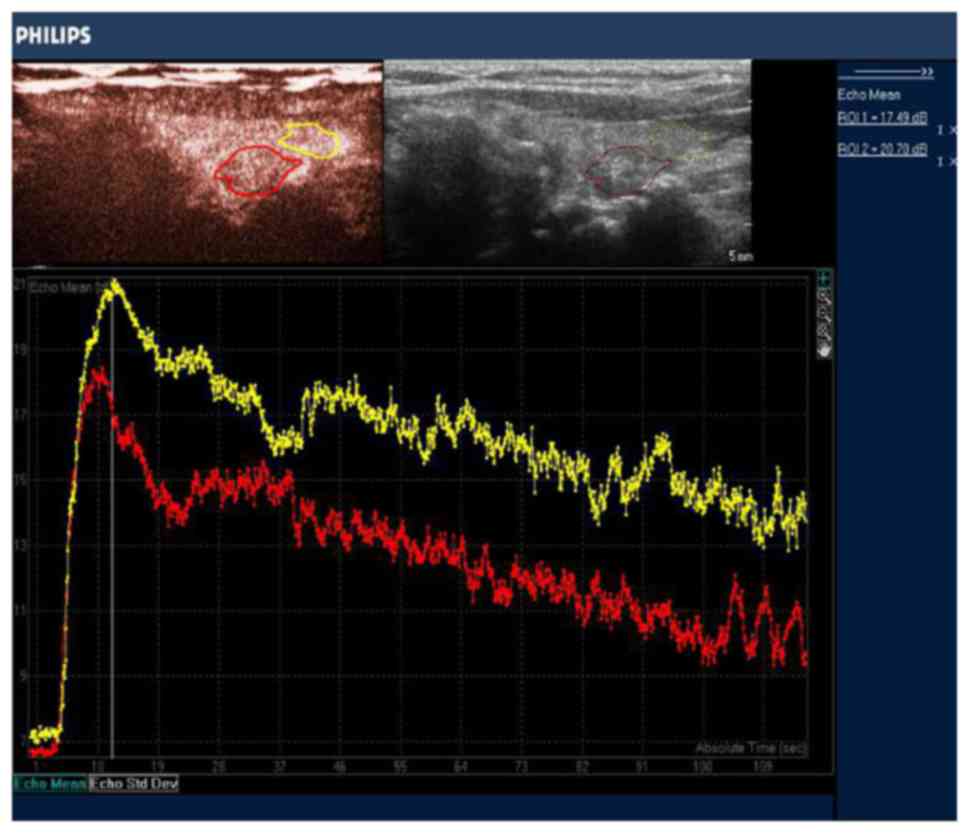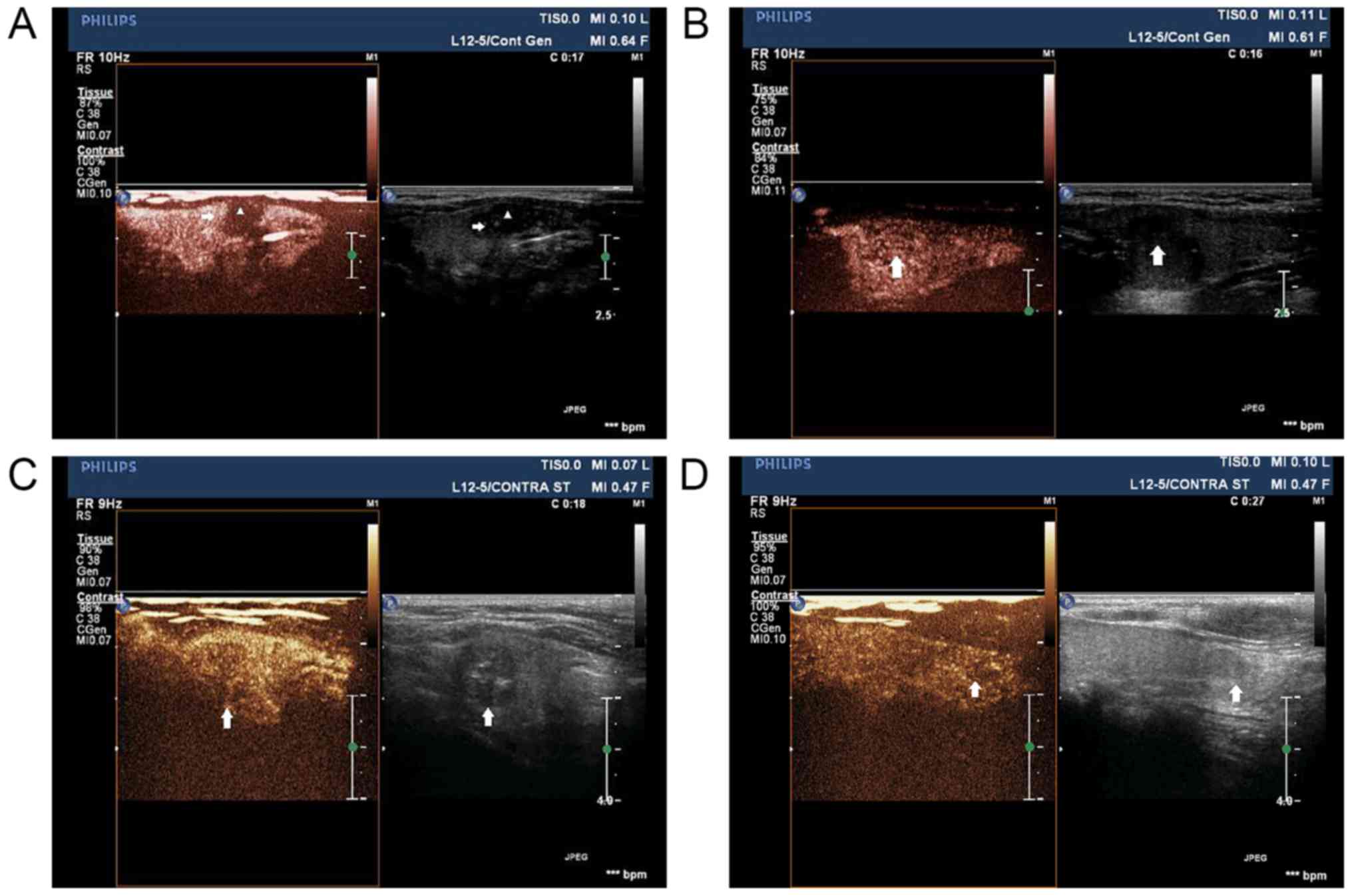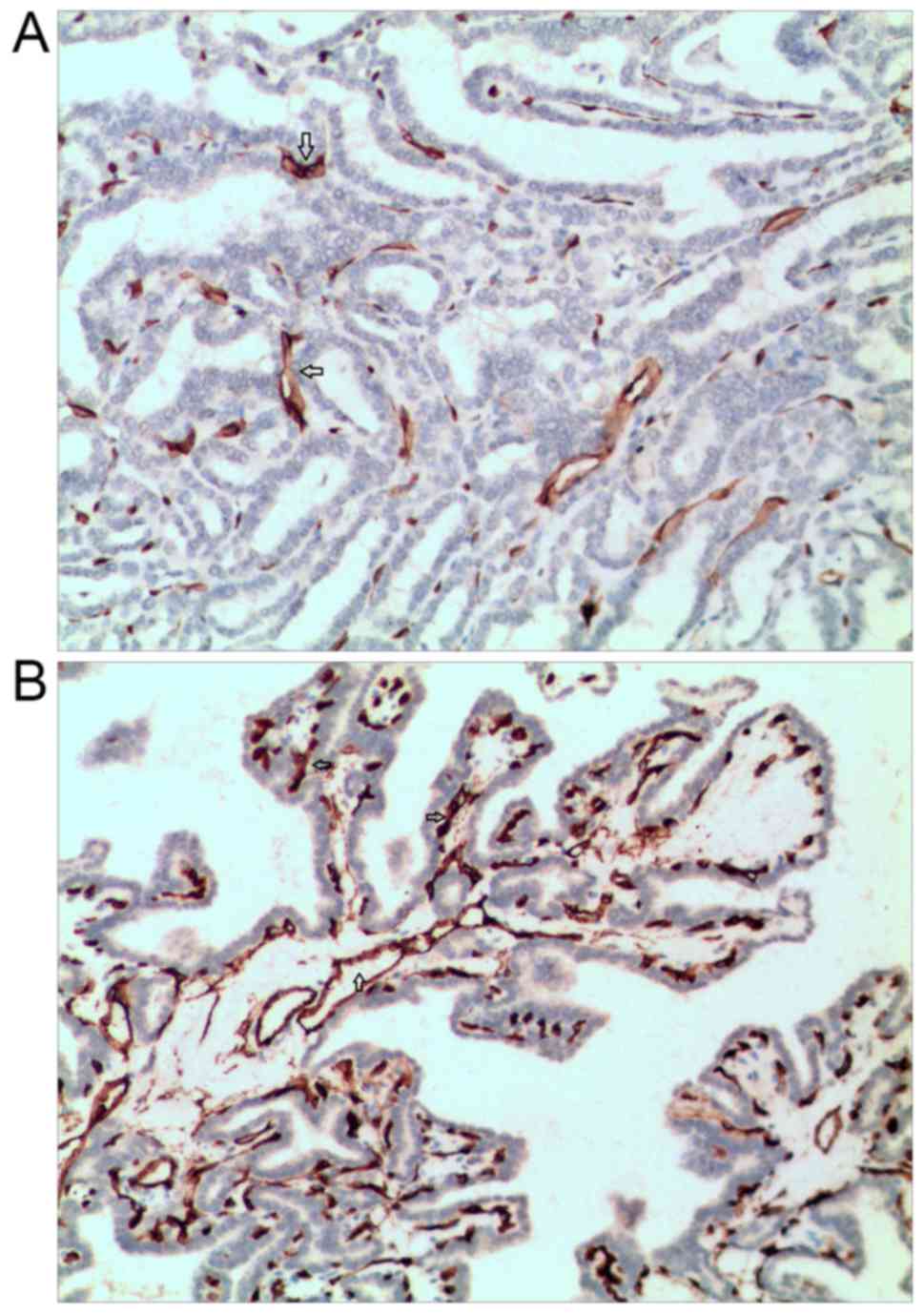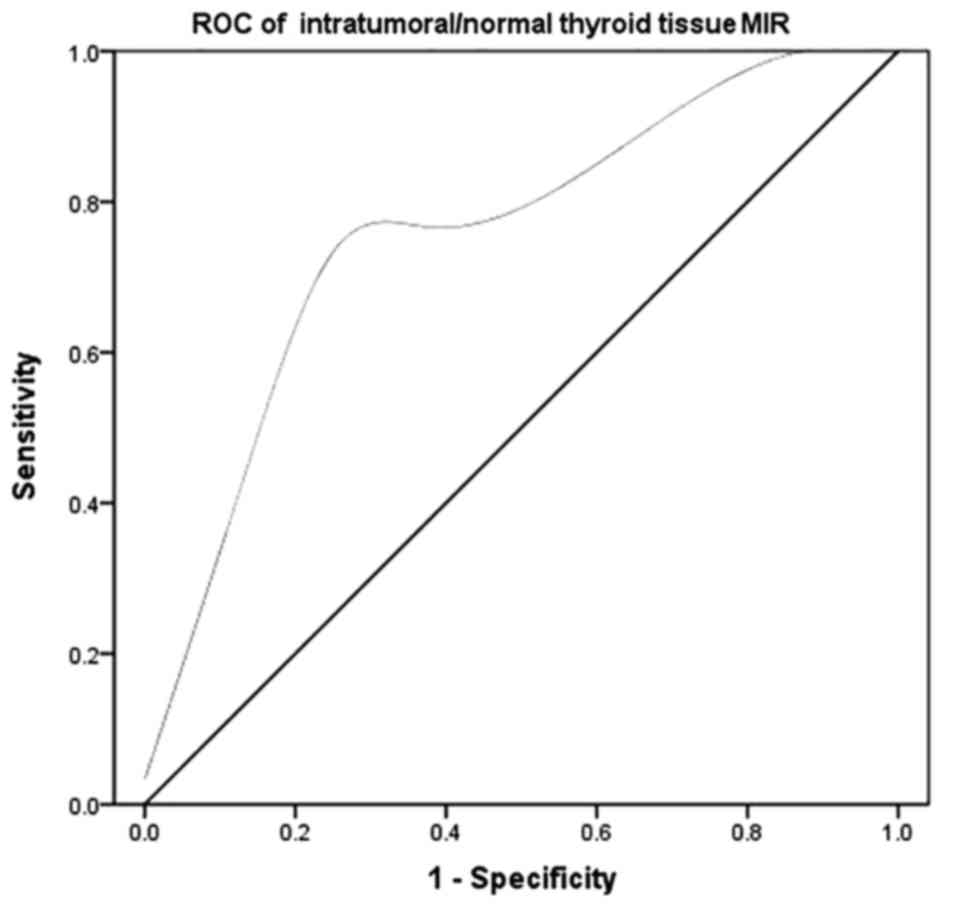|
1
|
Tian X, Cong M, Zhou W, Zhu J and Liu Q:
Relationship between protein expression of VEGF-C, MMP-2 and lymph
node metastasis in papillary thyroid cancer. J Int Med Res.
36:699–703. 2008. View Article : Google Scholar : PubMed/NCBI
|
|
2
|
Noguchi S, Murakami N, Yamashita H, Toda M
and Kawamoto H: Papillary thyroid carcinoma: Modified radical neck
dissection improves prognosis. Arch Surg. 133:276–280. 1998.
View Article : Google Scholar : PubMed/NCBI
|
|
3
|
American Thyroid Association (ATA)
Guidelines Taskforce on Thyroid Nodules and Differentiated Thyroid
Cancer, . Cooper DS, Doherty GM, Haugen BR, Kloos RT, Lee SL,
Mandel SJ, Mazzaferri EL, McIver B, Pacini F, et al: Revised
American Thyroid Association management guidelines for patients
with thyroid nodules and differentiated thyroid cancer. Thyroid.
19:1167–1214. 2009. View Article : Google Scholar : PubMed/NCBI
|
|
4
|
Gimm O, Rath FW and Dralle H: Pattern of
lymph node metastases in papillary thyroid carcinoma. Br J Surg.
85:252–254. 1998. View Article : Google Scholar : PubMed/NCBI
|
|
5
|
Machens A, Hinze R, Thomusch O and Dralle
H: Pattern of nodal metastasis for primary and reoperative thyroid
cancer. World J Surg. 26:22–28. 2002. View Article : Google Scholar : PubMed/NCBI
|
|
6
|
Hundahl SA, Fleming ID, Fremgen AM and
Menck HR: A national cancer data base report on 53,856 cases of
thyroid carcinoma treated in the U.S., 1985–1995. Cancer.
83:2638–2648. 1998. View Article : Google Scholar : PubMed/NCBI
|
|
7
|
Mercante G, Frasoldati A, Pedroni C,
Formisano D, Renna L, Piana S, Gardini G, Valcavi R and Barbieri V:
Prognostic factors affecting neck lymph node recurrence and distant
metastasis in papillary microcarcinoma of the thyroid. Results of a
study in 445 patients: Thyroid. 19:707–716. 2009.
|
|
8
|
Zhang L, Liu H, Xie Y, Xia Y, Zhang B,
Shan G and Li X: Risk factors and indication for dissection of
right paraesophageal lymph node metastasis in papillary thyroid
carcinoma. Eur J Surg Oncol. 42:81–86. 2016. View Article : Google Scholar : PubMed/NCBI
|
|
9
|
Haugen BR, Alexander EK, Bible KC, Doherty
GM, Mandel SJ, Nikiforov YE, Pacini F, Randolph GW, Sawka AM,
Schlumberger M, et al: 2015 American Thyroid Association management
guidelines for adult patients with thyroid nodules and
differentiated thyroid cancer. Thyroid. 26:1–133. 2016. View Article : Google Scholar : PubMed/NCBI
|
|
10
|
Wang N, Luo HJ, Yin GB, Dong CR, Xu M,
Chen GG and Liu ZM: Overexpression of HIF-2α, TWIST, and CXCR4 is
associated with lymph node metastasis in papillary thyroid
carcinoma. Clin Dev Immunol. 2013:5894232013. View Article : Google Scholar : PubMed/NCBI
|
|
11
|
Tang C, Yang L, Wang N, Li L, Xu M, Chen
GG and Liu ZM: High expression of GPER1, EGFR and CXCR1 is
associated with lymph node metastasis in papillary thyroid
carcinoma. Int J Clin Exp Pathol. 7:3213–3223. 2014.PubMed/NCBI
|
|
12
|
Machens A, Holzhausen HJ and Dralle H:
Skip metastases in thyroid cancer leaping the central lymph node
compartment. Arch Surg. 139:43–45. 2004. View Article : Google Scholar : PubMed/NCBI
|
|
13
|
Roh JL, Kim JM and Park CI: Lateral
cervical lymph node metastases from papillary thyroid carcinoma:
Pattern of nodal metastases and optimal strategy for neck
dissection. Ann Surg Oncol. 15:1177–1182. 2008. View Article : Google Scholar : PubMed/NCBI
|
|
14
|
Kouvaraki MA, Shapiro SE, Fornage BD,
Edeiken-Monro BS, Sherman SI, Vassilopoulou-Sellin R, Lee JE and
Evans DB: Role of preoperative ultrasonography in the surgical
management of patients with thyroid cancer. Surgery. 134:946–955.
2003. View Article : Google Scholar : PubMed/NCBI
|
|
15
|
Caliskan M, Park JH, Jeong JS, Lee CR,
Park SK, Kang SW, Jeong JJ, Chung WY and Park CS: Role of
prophylactic ipsilateral central compartment lymph node dissection
in papillary thyroid microcarcinoma. Endocr J. 59:305–311. 2012.
View Article : Google Scholar : PubMed/NCBI
|
|
16
|
Wada N, Duh QY, Sugino K, Iwasaki H,
Kameyama K, Mimura T, Ito K, Takami H and Takanashi Y: Lymph node
metastasis from 259 papillary thyroid microcarcinomas: Frequency,
pattern of occurrence and recurrence, and optimal strategy for neck
dissection. Ann Surg. 237:399–407. 2003. View Article : Google Scholar : PubMed/NCBI
|
|
17
|
White ML, Gauger PG and Doherty GM:
Central lymph node dissection in differentiated thyroid cancer.
World J Surg. 31:895–904. 2007. View Article : Google Scholar : PubMed/NCBI
|
|
18
|
Eloy C, Santos J, Soares P and
Sobrinho-Simões M: Intratumoural lymph vessel density is related to
presence of lymph node metastases and separates encapsulated from
infiltrative papillary thyroid carcinoma. Virchows Arch.
59:595–605. 2011. View Article : Google Scholar
|
|
19
|
Lee K, Park DJ, Choe G, Kim HH, Kim WH and
Lee HS: Increased intratumoral lymphatic vessel density correlates
with lymph node metastasis in early gastric carcinoma. Ann Surg
Oncol. 17:73–80. 2010. View Article : Google Scholar : PubMed/NCBI
|
|
20
|
Folkman J, Merler E, Abernathy C and
Williams G: Isolation of a tumor factor responsible for
angiogenesis. J Exp Med. 133:275–288. 1971. View Article : Google Scholar : PubMed/NCBI
|
|
21
|
Zhan WW, Zhou P, Zhou JQ, Xu SY and Chen
KM: Differences in sonographic features of papillary thyroid
carcinoma between neck lymph node metastatic and nonmetastatic
groups. J Ultrasound Med. 31:915–920. 2012. View Article : Google Scholar : PubMed/NCBI
|
|
22
|
Hakala T, Sand J, Kellokumpu-Lehtinen PL,
Huhtala H, Leinonen R and Kholová I: Recurrent thyroid cancers have
more peritumoural lymphatic vasculature than nonrecurrent thyroid
cancers. Eur J Clin Invest. 44:825–832. 2014. View Article : Google Scholar : PubMed/NCBI
|
|
23
|
Chen M, Zhang KQ, Xu YF, Zhang SM, Cao Y
and Sun WQ: Shear wave elastography and contrast-enhanced
ultrasonography in the diagnosis of thyroid malignant nodules. Mol
Clin Oncol. 5:724–730. 2016. View Article : Google Scholar : PubMed/NCBI
|
|
24
|
Piscaglia F, Nolsøe C, Dietrich CF,
Cosgrove DO, Gilja OH, Nielsen Bachmann M, Albrecht T, Barozzi L,
Bertolotto M, Catalano O, et al: The EFSUMB guidelines and
recommendations on the clinical practice of contrast enhanced
ultrasound (CEUS): Update 2011 on non-hepatic applications.
Ultraschall med. 33:33–59. 2012. View Article : Google Scholar : PubMed/NCBI
|
|
25
|
Rosário PW, de Faria S, Bicalho L, Alves
MF, Borges MA, Purisch S, Padrão EL, Rezende LL and Barroso AL:
Ultrasonographic differentiation between metastatic and benign
lymph nodes in patients with papillary thyroid carcinoma. J
Ultrasound Med. 24:1385–1389. 2005. View Article : Google Scholar : PubMed/NCBI
|
|
26
|
Weidner N, Semple JP, Welch WR and Folkman
J: Tumor angiogenesis and metastasis-correlation in invasive breast
carcinoma. N Engl J Med. 324:1–8. 1991. View Article : Google Scholar : PubMed/NCBI
|
|
27
|
Ceresini G, Corcione L, Morganti S, Milli
B, Bertone L, Prampolini R, Petrazzoli S, Saccani M, Ceda GP and
Valenti G: Ultrasound-guided fine-needle capillary biopsy of
thyroid nodules, coupled with on-site cytologic review, improves
results. Thyroid. 14:385–389. 2004. View Article : Google Scholar : PubMed/NCBI
|
|
28
|
Tabaqchali MA, Hanson JM, Johnson SJ,
Wadehra V, Lennard TW and Proud G: Thyroid aspiration cytology in
Newcastle: A six year cytology/histology correlation study. Ann R
Coll Surg Engl. 82:149–155. 2000.PubMed/NCBI
|
|
29
|
Hay ID, Thompson GB, Grant CS, Bergstralh
EJ, Dvorak CE, Gorman CA, Maurer MS, McIver B, Mullan BP, Oberg AL,
et al: Papillary thyroid carcinoma managed at the Mayo Clinic
during six decades (1940–1999): Temporal trends in initial therapy
and long-term outcome in 2444 consecutively treated patients. World
J Surg. 26:879–885. 2002. View Article : Google Scholar : PubMed/NCBI
|
|
30
|
Yamashita H, Noguchi S, Murakami N,
Kawamoto H and Watanabe S: Extracapsular invasion of lymph node
metastasis is an indicator of distant metastasis and poor prognosis
in patients with thyroid papillary carcinoma. Cancer. 80:2268–2272.
1997. View Article : Google Scholar : PubMed/NCBI
|
|
31
|
Xiang D, Hong Y, Zhang B, Huang P, Li G,
Wang P and Li Z: Contrast-enhanced ultrasound (CEUS) facilitated US
in detecting lateral neck lymph node metastasis of thyroid cancer
patients: Diagnosis value and enhancement patterns of malignant
lymph nodes. Eur Radiol. 24:2513–2519. 2014. View Article : Google Scholar : PubMed/NCBI
|
|
32
|
Na DK, Choi YJ, Choi SH, Kook SH and Park
HJ: Evaluation of cervical lymph node metastasis in thyroid cancer
patients using real-time CT-navigated ultrasonography: Preliminary
study. Ultrasonography. 34:39–44. 2015. View Article : Google Scholar : PubMed/NCBI
|
|
33
|
Lang BH, Lo CY, Chan WF, Lam KY and Wan
KY: Staging systems for papillary thyroid carcinoma: A review and
comparison. Ann Surg. 245:366–378. 2007. View Article : Google Scholar : PubMed/NCBI
|
|
34
|
Qu N, Zhang L, Ji QH, Chen JY, Zhu YX, Cao
YM and Shen Q: Risk factors for central compartment lymph node
metastasis in papillary thyroid microcarcinoma: A meta-analysis.
World J Surg. 39:2459–2470. 2015. View Article : Google Scholar : PubMed/NCBI
|
|
35
|
Meng XY, Zhang Q, Li Q, Lin S and Li J:
Immunohistochemical levels of cyclo-oxygenase-2, matrix
metalloproteinase-9 and vascular endothelial growth factor in
papillary thyroid carcinoma and their clinicopathological
correlations. J Int Med Res. 42:619–627. 2014. View Article : Google Scholar : PubMed/NCBI
|
|
36
|
Sun XF and Zhang H: Clinicopathological
significance of stromal variables: Angiogenesis, lymphangiogenesis,
inflammatory infiltration, MMP and PINCH in colorectal carcinomas.
Mol Cancer. 5:432006. View Article : Google Scholar : PubMed/NCBI
|
|
37
|
Dufort S, Sancey L, Hurbin A, Foillard S,
Boturyn D, Dumy P and Coll JL: Targeted delivery of a proapoptotic
peptide to tumors in vivo. J Drug Target. 19:582–588. 2011.
View Article : Google Scholar : PubMed/NCBI
|
|
38
|
Yu XM, Lo CY, Lam AK, Leung P and Luk JM:
Serum vascular endothelial growth factor C correlates with lymph
node metastases and high-risk tumor profiles in papillary thyroid
carcinoma. Ann Surg. 247:483–489. 2008. View Article : Google Scholar : PubMed/NCBI
|


















